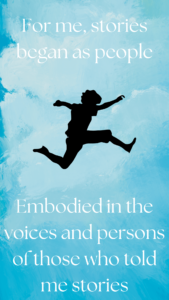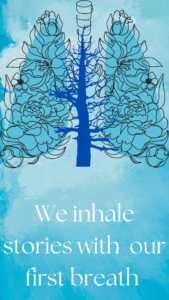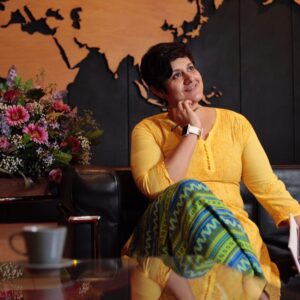
Are you interested in writing that examines how changes in media affect the way we read and write?
Virtual resident Akshita Nanda explores just that: how do we find stories, and how do they find us? Far from bemoaning the forever-growing popularity of social media channels, Akshita wants to observe the effect of different ways of sharing stories and communicating with each other. Through a mix of illustrations and personal insights, she thinks meaningfully about the stories we tell and how they can transform the spaces we occupy. In stories part-true, part-imagined, Akshita proves that ‘the boundaries between virtual and real are always fluid.’
Akshita wrote this piece during a 2022 virtual residency with NCW, generously supported by the National Arts Council of Singapore.
Embodied in Fiction
I am primarily a writer and consumer of long-form text. When I think about the experience of fiction, I am fascinated by the way intangible ideas affect our physical bodies.
Writing or otherwise creating stories is a physical act. Words are scribbled, typed or spoken into air. Human muscle and nerves and sinew weave words into patterns called stories that can elicit laughter, tears and change the behaviour of both creator and recipient.
Stories originate from physical bodies and are received again in physical form; stored and interpreted in books or magazines or oral tradition or the patterns of neurotransmitters and nerve-ends firing in our brains.
Stories are embodied in and around us.
During my virtual residency in Norwich, I explored how we generate, transmit and participate in stories – embody them and consume them.
Attention spans are changing, as are the ways in which people encounter and experience stories.

I was born eleven years before cable television became commonplace in middle-income households. I first encountered stories in the human voice, as people read to me or told me bedtime tales. The memory of fables like that of the monkey and the crocodile come wrapped in the feel of blankets and the sensation of listening to the rumble of a voice while nestled in the crook of a grandparental arm.
For most of my life, stories came to me primarily through printed media. An archaeological examination of my bookshelves reveals decades of evolving tastes. A statistical examination of my bookshelves reveals a decade-long deceleration in the pace of acquisition. I still buy physical books but, for reasons of economy and convenience, do most of my reading on a screen.
How else are stories embodied today? A child today might be more familiar with the disembodied human voice coming from a screen. As a writer of fiction and a reading tutor, I do not think this is something to lament. It is something to be noted and considered when I create.
The medium of storytelling and the mode of transmission has changed thanks to technologically sped up communication. What has not changed is that we love stories.


Whether short videos, bite-size blocks of text shared on social media or brick-thick printed novels, we hunger to be taken out of ourselves and to have our views on the world revolutionised – or, increasingly, affirmed.
We tell ourselves stories about who we are, individually, as a society, as a community, or as an oppositional entity.
Stories travel between people, between cultures and across seas. Stories travel and change the world.

Until very recently, stories tended to move with the speed of human mobility. Tales travelled through voice and print. People literally spread the word. Travellers took their myths, fabrics, behaviours and ingredients across land and sea, either deliberately or unconsciously influencing those they met.
About two hundred years ago, human engineering outstripped the speed of human conveyance. Stories began flashing through the sky and snaking through the sea. Radio, television and now transcontinental cable networks bring stories to us almost as quickly as the originator composes them.
It seems akin to the old bardic, nomadic traditions in which news-bearers and tale-tellers moved between homes and communities. They brought information about weather and war and matrimonial prospects. They exchanged gossip about everyday politicking and also about the deeds of the unseen supernatural beings that their community believed in.
The method of transmission may have changed but today, more than ever, storytellers embody the stories they tell.
I find problems with this, as readers conflate authors with their fiction. I also see opportunities to expand my storytelling technique through the use of contemporary media.
Stories are becoming shorter and more visual. Beyond the short story, novella and epic novel, we now have more recipients than ever for the WhatsApp forward, the Twitter thread and TikTok reel; the Facebook community and LinkedIn group
This affects how I tell stories.
Too much text? TLDR.
Only visuals? Inaccessible to many unless uploaded with alt text.
Fact or fiction? The boundaries increasingly overlap.
The way stories are told and presented online matters more than ever now.
Read the whole piece →


Akshita Nanda is a journalist, analyst and author of the novels Beauty Queens of Bishan (Penguin Random House SEA) and Nimita’s Place (Epigram Books). Nimita’s Place was adapted for the stage in 2019 by arts group T:>Works and in 2020 co-won the Singapore Literature Prize for English fiction.
Akshita’s fiction explores the migration of people and ideas – beliefs, fashions, memes, technology – and also how the dislocated become local. During her residency, she focussed on how such migration is accelerated through globalisation, and how this changes people’s lives.
In 2022, the National Centre for Writing offered three virtual residencies for writers from Singapore, generously supported by the National Arts Council of Singapore. The writers were Akshita Nanda, Crispin Rodrigues and Daryl Qilin Yam. Over the six months, the Singaporean writers worked on a project with a UK-based writer as mentor. They also met online with writers and translators connected with Norwich, took part in an interview for The Writing Life podcast and participated in Meet the World events. At the end of the residency, we commissioned a piece from each writer reflecting on their residency and their writing. They also contributed writing tips and a blog for Walking Norwich. Read more here →
You may also like...
Solitude/Fortitude
Thoughts on loneliness, music and writing with, or without others from an NCW virtual resident

17th February 2023
Top tips for mindful writing from Akshita Nanda
Our Meet the World virtual resident advises on writing in a way that puts you first

10th February 2023
Wattpad, serialisation and online readers
Creating new spaces for writers and readers

23rd January 2017






